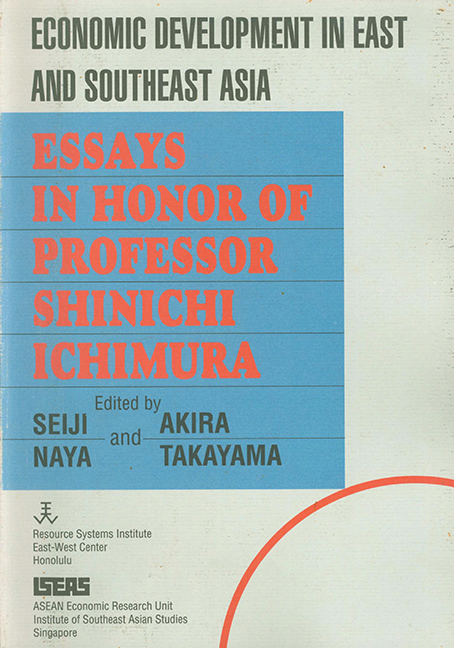Book contents
- Frontmatter
- Preface
- Shinichi Ichimura, 1925-
- CONTENTS
- Introduction
- Contributors to This Volume
- I Structural Change and Economic Development in Developing Asia in the 1990s
- II Explaining the Success of the Four Little Dragons: A Survey
- III Taiwan's Economic Miracle: A Singaporean Perspective
- IV Singapore's Experience of Industrial Restructuring: Lessons for the Other Asian NIEs
- V Korean Industrial Policies for Declining Industries
- VI Vietnam: Recent Economic Developments and the World Economy
- VII Transition from Import Substitution to Export Expansion: The Thai Experience
- VIII Adjustment Problems of a Small Oil-Exporting Country: Did Indonesia Suffer from the Dutch Disease?
- IX A Quarterly Econometric Model of the Hong Kong Economy
- X The Effect ofRicardian Rent Extracting on Macroeconomic Performance
- XI Direct Foreign Investment and the Economic Development of Korea
- XII Japanese Investment in Thailand: Looking Back and Into the Future
- XIII The Effects of Direct Foreign Investment on Taiwan: A Macroeconometric Investigation
- XIV A Reform of the Foward Foreign Exchange Market and Foreign Exchange Rate Determination Policy in Korea, with Foreign Exchange Policy Experiences of Taiwan
- XV Interest Rate and Foreign Exchange Liberalization in Taiwan in the 1980
- XVI Manifold Dilemmas behind External Debt Management
- XVII Agricultural Growth and Food Imports in Developing Countries: A Reexamination
- XVIII The Transformation of Rural Asia and Economic Development Theory and Policy
- XIX The ASEAN Summit and ASEAN Economic Cooperation
- XX The Role of Developing Countries in the New GATT Round
- XXI The Emerging Global Economy and the Role of the Asian NIEs
- Index
XVII - Agricultural Growth and Food Imports in Developing Countries: A Reexamination
Published online by Cambridge University Press: 21 October 2015
- Frontmatter
- Preface
- Shinichi Ichimura, 1925-
- CONTENTS
- Introduction
- Contributors to This Volume
- I Structural Change and Economic Development in Developing Asia in the 1990s
- II Explaining the Success of the Four Little Dragons: A Survey
- III Taiwan's Economic Miracle: A Singaporean Perspective
- IV Singapore's Experience of Industrial Restructuring: Lessons for the Other Asian NIEs
- V Korean Industrial Policies for Declining Industries
- VI Vietnam: Recent Economic Developments and the World Economy
- VII Transition from Import Substitution to Export Expansion: The Thai Experience
- VIII Adjustment Problems of a Small Oil-Exporting Country: Did Indonesia Suffer from the Dutch Disease?
- IX A Quarterly Econometric Model of the Hong Kong Economy
- X The Effect ofRicardian Rent Extracting on Macroeconomic Performance
- XI Direct Foreign Investment and the Economic Development of Korea
- XII Japanese Investment in Thailand: Looking Back and Into the Future
- XIII The Effects of Direct Foreign Investment on Taiwan: A Macroeconometric Investigation
- XIV A Reform of the Foward Foreign Exchange Market and Foreign Exchange Rate Determination Policy in Korea, with Foreign Exchange Policy Experiences of Taiwan
- XV Interest Rate and Foreign Exchange Liberalization in Taiwan in the 1980
- XVI Manifold Dilemmas behind External Debt Management
- XVII Agricultural Growth and Food Imports in Developing Countries: A Reexamination
- XVIII The Transformation of Rural Asia and Economic Development Theory and Policy
- XIX The ASEAN Summit and ASEAN Economic Cooperation
- XX The Role of Developing Countries in the New GATT Round
- XXI The Emerging Global Economy and the Role of the Asian NIEs
- Index
Summary
Introduction
The relationship between agricultural growth and food imports in developing countries has recently attracted renewed interest among agricultural and trade economists. This is largely in reaction to the strong opposition by farm lobbies in the United States to development assistance programs abroad that promote foodgrain production allegedly to the detriment of U.S. agricultural interests, which in turn was stimulated by the substantial fall in U.S. farm exports since 1981.
The major food crops, including cereals, roots and tubers, pulses, groundnuts, plaintains and bananas, account for the bulk of total calorie intake in developing countries. Although they are net exporters of noncereal food staples, developing countries as a group import cereals much more heavily. For example, developing countries' exports of noncereal food crops averaged 7.8 million tons annually during the period 1979-83 which was only about one-sixth of their net cereals imports over the same period. It seems reasonable, therefore, to use the terms “food imports” and “net cereal imports” interchangeably in this paper.
Nine years ago, Bachman and Paulino (1979) observed a strongly positive effect of agricultural growth on food imports of developing countries during the period 1961-76 and concluded that “staple food exporters have little cause to worry about the rapid growth of food production in the developing countries” (p. 35). A number of more recent studies have also documented the historical and cross-country correlations between agricultural growth and food imports through the early 1980s (Kellogg 1985; Lee and Shane 1985; Houck 1986; Timmer 1987).
The volume of food imports to developing countries actually increased in the 1980s, but other developed countries have gained larger market shares than the United States. It would seem then that the observed decline in U.S. agricultural exports in the 1980s has been caused by factors other than the growth of farm output in developing countries, involving the “international recession, currency exchange rates, bumper crops around the globe, international debt repayment problems, political maneuvering, and trade-strangling policy adjustments” (Houck 1986, p. 2).
The positive correlation between agricultural growth in developing countries and increases in their food imports is typically specified at a high level of country aggregation; as some writers have pointed out, there are some exceptions to the general rule (Paarlberg 1986).
- Type
- Chapter
- Information
- Economic Development in East and Southeast AsiaEssays in Honor of Professor Shinichi Ichimura, pp. 266 - 280Publisher: ISEAS–Yusof Ishak InstitutePrint publication year: 1990



